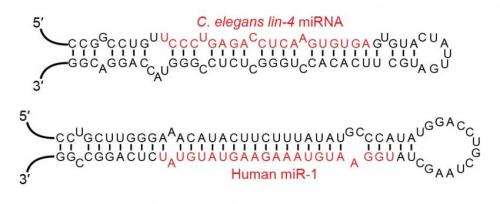June 13, 2016 report
Tweaked deep sequencing technique allows for profiling microRNA in mice

(Medical Xpress)—A team of researchers working at the Chinese Academy of Sciences has developed a means for tweaking a deep sequencing technique that allows for profiling mouse oocytes and early embryos. In their paper published in the journal Science Advances, the team describes the tweaks they made and also what they found when they used their new technique on mice.
MicroRNA (miRNA) are cellular fragments of RNA that in some organisms prevent the production of certain proteins. They have been found to be expressed in tissues of some non-mammals and in some embryos prior to pre-implantation. Little is known about their function in mammals, however, though prior research had found them to exist in oocytes (ovarian cells that lead to the development of an ovum) and early embryos. Prior efforts to deep sequence them in mammals has proved to be extremely challenging due to the numbers of them that must be processed, thus scientists still do not know what role they may play in embryo development, if any. In this new effort, the researchers report that they have found a way to tweak the cDNA library construction method for small RNAs resulting in a need for only 10 nanograms of RNA for doing a deep sequence, and because of that, were able to profile samples of both mouse oocytes and early embryos.
To tweak the construction method, the researchers optimized the 5' and 3' adaptor ligation and PCR amplification steps, which allowed for drastically reducing the amount of RNA needed. To test their ideas they performed the tweaking on 293 human embryonic kidney cells. Once they had the technique developed, they switched to testing mice oocytes and early embryos to learn more about the role of miRNA in mammal embryo development. They report that they were able to trace the processes surrounding miRNA as it moved from fertilization to early embryonic development—which was the first time that had ever been done. Furthermore, they found that the role miRNA played was suppressed as initial cell division was occurring—though it was not clear why that occurred—but later it was reactivated, perhaps as part of the process of regulating zygotic genetic growth factors.
The researchers suggest their new technique may prove useful for further study of the role that miRNA plays in embryonic development.
More information: Q. Yang et al. Highly sensitive sequencing reveals dynamic modifications and activities of small RNAs in mouse oocytes and early embryos, Science Advances (2016). DOI: 10.1126/sciadv.1501482
Abstract
Small RNAs play important roles in early embryonic development. However, their expression dynamics and modifications are poorly understood because of the scarcity of RNA that is obtainable for sequencing analysis. Using an improved deep sequencing method that requires as little as 10 ng of total RNA or 50 oocytes, we profile small RNAs in mouse oocytes and early embryos. We find that microRNA (miRNA) expression starts soon after fertilization, and the mature miRNAs carried into the zygote by sperm during fertilization are relatively rare compared to the oocyte miRNAs. Intriguingly, the zygotic miRNAs display a marked increase in 3′ mono- and oligoadenylation in one- to two-cell embryos, which may protect the miRNAs from the massive degradation taking place during that time. Moreover, bioinformatics analyses show that the function of miRNA is suppressed from the oocyte to the two-cell stage and appears to be reactivated after the two-cell stage to regulate genes important in embryonic development. Our study thus provides a highly sensitive profiling method and valuable data sets for further examination of small RNAs in early embryos.
© 2016 Medical Xpress



















